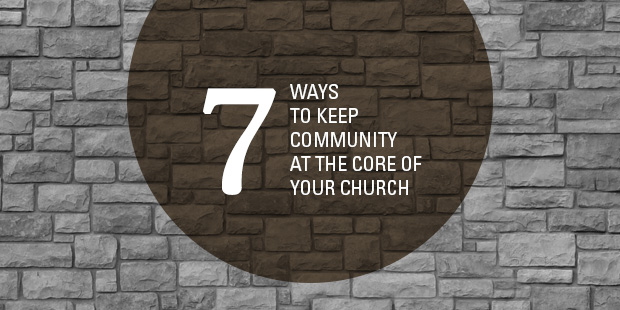
7 Ways to Keep Community at the Core of Your Church
I had the privilege of being with some great yet humble pastoral leaders last week at a forum in Atlanta. These 22 men and women are responsible for creating a climate where group life and effective teams can flourish in and through the life of the local church. Some world-renown churches were represented (Saddleback, LifeChurch, North Point) and some lesser known communities (Westridge, Sojourn, and Southridge in Canada) rounded out the list.
Church size, personal popularity, resources published, ministry longevity or the level of creativity were not the factors that made these leaders or their churches “great” in my eyes. Rather, they were successful because they maintained a relentless commitment to becoming a church with community at the core of everything they do.
Why? Because they knew and believed there is no discipleship without relationship! There can be no mass disciple-making using events and programs. Yes, you can create more followers with creative events, spectacular services and dynamic speakers. But you cannot make disciples.
As I listened to these friends and fellow leaders, it was clear that communal life and how it can change the world was truly at the center. It was not an afterthought, an add-on to be considered after focusing on fundraising, events, services, classes, programs and activities. I long for that kind of church.
But to be a place where community is at the core you must first believe that it really belongs there, where God put it and where Jesus lived it. And you must build everything around it. The heart of the gospel is community – the message that the God who lives in community came to restore community with his people through the life, death and resurrection of his son. (John 17:21)
How do we Become a Place with Community at the Core?
Here are some of the key insights that these leaders shared or that I took away as we engaged deeply about what it means for community to be central to the core of a church to catalyze spiritual growth and maximize world impact.
- Strategy Matters: Organic growth is cool and new experiments are essential, but at the end of the day you need a cohesive, coherent strategy for building community life. It must not be so rigid as to inhibit innovation, nor so loose as to create unmanageable chaos. But you need one – missional groups, meta-church, life transformation groups, mid-sized communities…the models vary but not the need for a unified, cohesive strategy. And be careful not to over-program. The emerging discussion about Missional Communities was very provocative.
- Clarity is King: Why do we do groups? What is our desired outcome? How do people get connected? Where do we find emerging leaders and how do we equip them? There are many questions and problems to solve, and most of them are complex or require real effort. But if you are committed to achieving clarity, you have most of the problem solved already. See Stanley on this.
- Culture-Transformation is our Mission. Many Christians either attack the culture or run from it. But we are not called to build a community of navel gazers, obsessed with promoting an insulated, fortress mentality. People are lost, hurting, lonely, fear-filled, poor, hungry, homeless, hopeless, friendless, oppressed, unemployed, wounded and sick. We build community to strengthen the body AND enter the culture with a Luke 4 mindset. In God’s power we are setting captives free, bringing sight to the spiritually blind, offering good news and hope to the poor, and shouting out “God’s favor has come!”
- Stories Stir the Soul: Listening to the stories of others and telling our story is a powerful way to connect people and build relationships with those outside our circle. Then we can connect our stories to God’s story.
- Metrics Motivate the Mind: You get what you measure, but you cannot gauge progress without some markers. Without measurement there is no management. Plan to measure qualitative and quantitative growth, getting feedback so that you can focus your training and development of people.
- Leaders Make a Big Difference: We all advocate the vision of shared ministry, mutual use of gifts, empowering one another to serve, and taking ownership of ministry at every level. But we also know that quality, committed leadership matters. We want a flatter kind of church structure, and we know that leaders themselves have a big role in making that happen. We have to give more away, take more risks, allow others to fail, and be the first to work ourselves out of a job. See my post about your leadership.
- The Good News is the Best News: We affirmed our commitment to the gospel-story of Jesus, teaching His way of being with people, loving others, living a sacrificial life, redeeming us from sin and shame, and putting us on a new path toward abundant life.
I was so proud to be in the room with such an amazing group of servants whose hearts are tender, minds are sharp, and souls long for real change. And who can laugh at themselves (and one another!) in a way that is simply pure joy.
Questions to consider:
- With whom do you gather for this kind of inspiration?
- Where do you get real interaction and thought-provoking conversation?
- Where do you discover fresh ideas and see strategies that actually work in real life? Not just more speakers and content and information – but real engagement about life and ministry issues that produces lasting change?

Tags: Bill Donahue, Community, Duplication, Small Groups











